The Ultimate Guide to Installing an Artificial Putting Greens
Introduction: Are you dreaming of having your own personal putting green at home? Look no further! With the right guidance and high-quality products from Premium Grass Blades, you can create a stunning artificial putting green that will enhance your golfing skills and impress your friends. In this step-by-step guide, we’ll walk you through the process of installing an artificial putting green with ease, even if you’re a beginner.
Materials Needed:
- Artificial putting green turf (such as Sports Putt 50 from Premium Grass Blades)
- Digging tools (shovels, spades, etc.)
- Road base
- Crusher dust
- Weed barrier
- Putting green cups and flags
- Vibratory plate compactor (optional)
- Rake
- Water source
Step 1:
Preparing the Area Start by selecting a suitable location for your putting green. Clear the area of any debris and vegetation. It’s essential to dig down approximately 6 inches to create a solid base for your putting green. This depth ensures proper drainage and a stable surface.
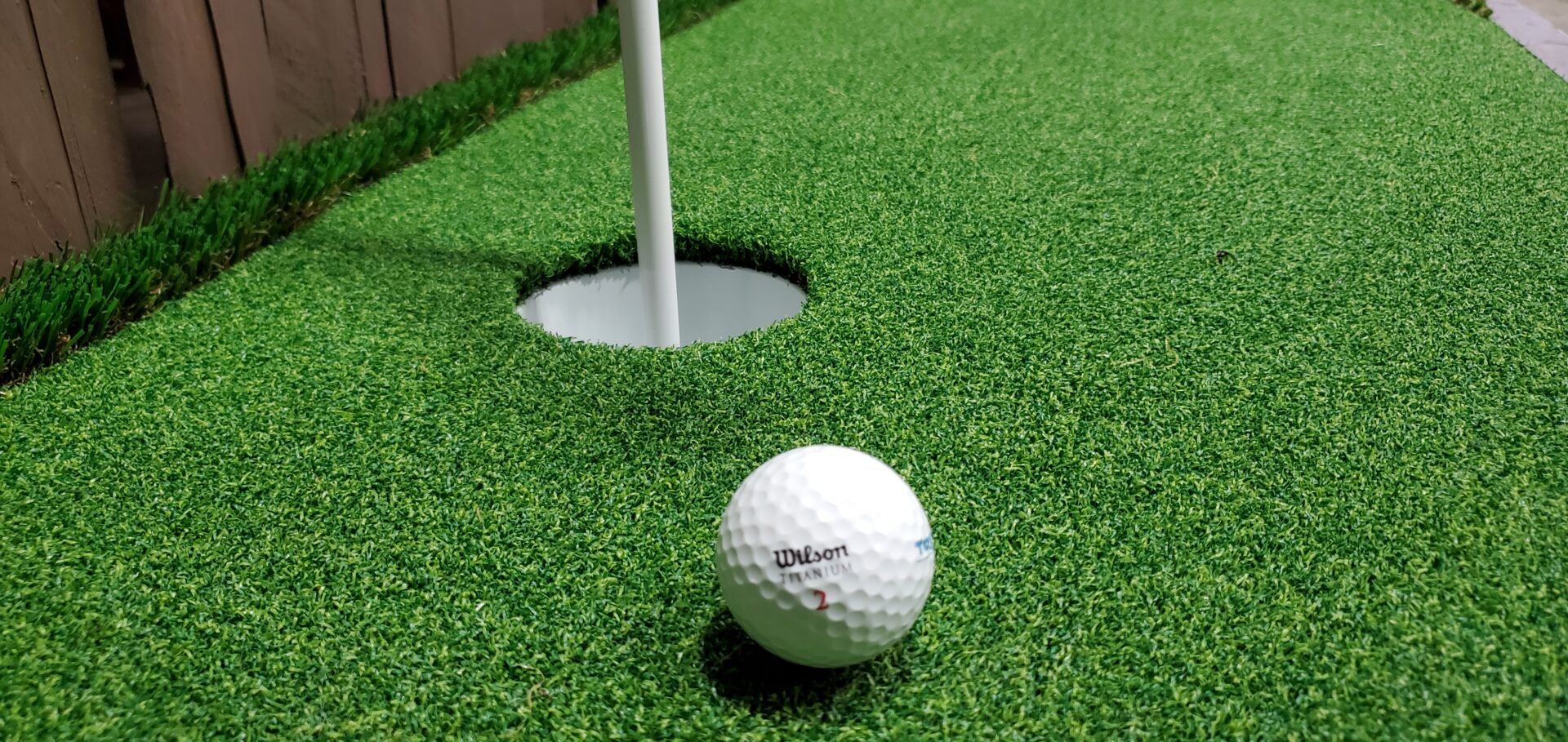
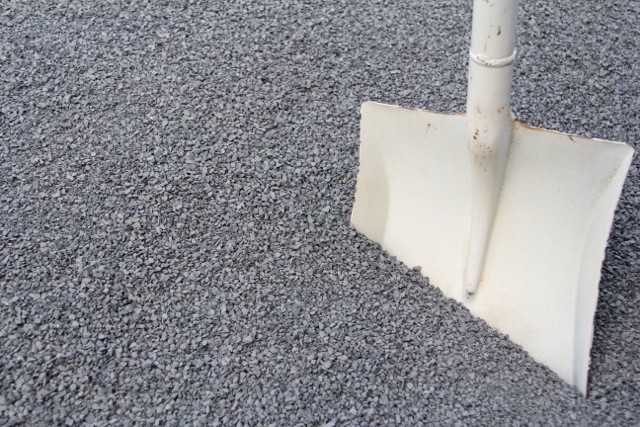
Step 2:
Building the Base Once the area is excavated, bring the infill back up with 4 inches of road base. Spread it evenly and use a rake to level the surface. Compact the road base using a vibratory plate compactor (if available) to create a firm and even foundation. This step is crucial for the long-term stability of your putting green. Premium Grass Blades does rent a vibratory plate compactor. Please contact us for details and cost.
Step 3:
Adding the Finishing Layers After compacting the road base, apply a layer of 1 inch of crusher dust on top. Use a rake to spread it evenly across the surface. This layer helps create a smooth and even playing surface for your putting green. Before proceeding to the next step, make sure the crusher dust is thoroughly compacted. Spray a light mist of water over the crusher dust each time you compact, as this helps to bind the crusher dust together for a solid foundation.

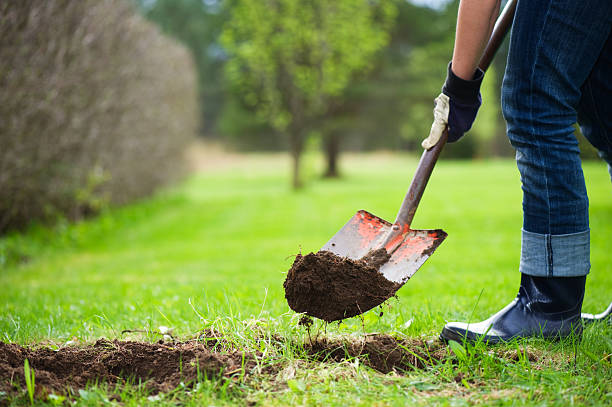
Step 4:
Installing the Weed Barrier To prevent weeds from penetrating the putting green, lay a weed barrier over the crusher dust. Cut the barrier to fit the area and secure it in place using landscape staples. This step ensures that your putting green remains weed-free and low-maintenance. This also acts as a buffer to muffle the sound of the crusher dust between your putting green turf. It also helps to not pull any rocks up if you need to move your turf around.
Step 5:
Unrolling and Securing the Artificial Turf Now it’s time to install the star of the show – the artificial putting green turf. Unroll the turf carefully, ensuring that it covers the entire area. Trim any excess turf with a utility knife.. Take your time to ensure a smooth and seamless installation. Seaming Putting Green is very hard to do, and near impossible to get the seamline to disappear. Seaming putting green should be avoided.
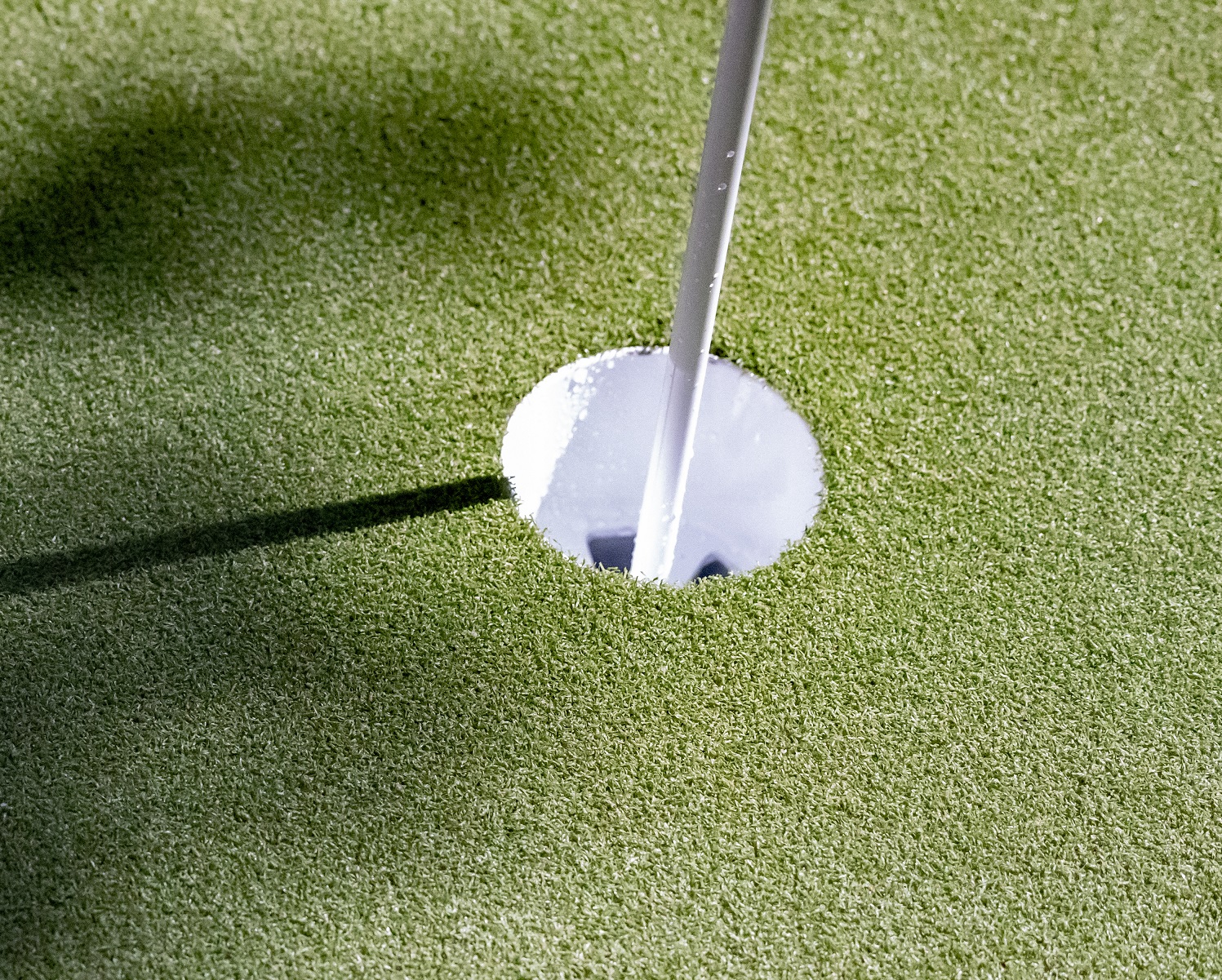
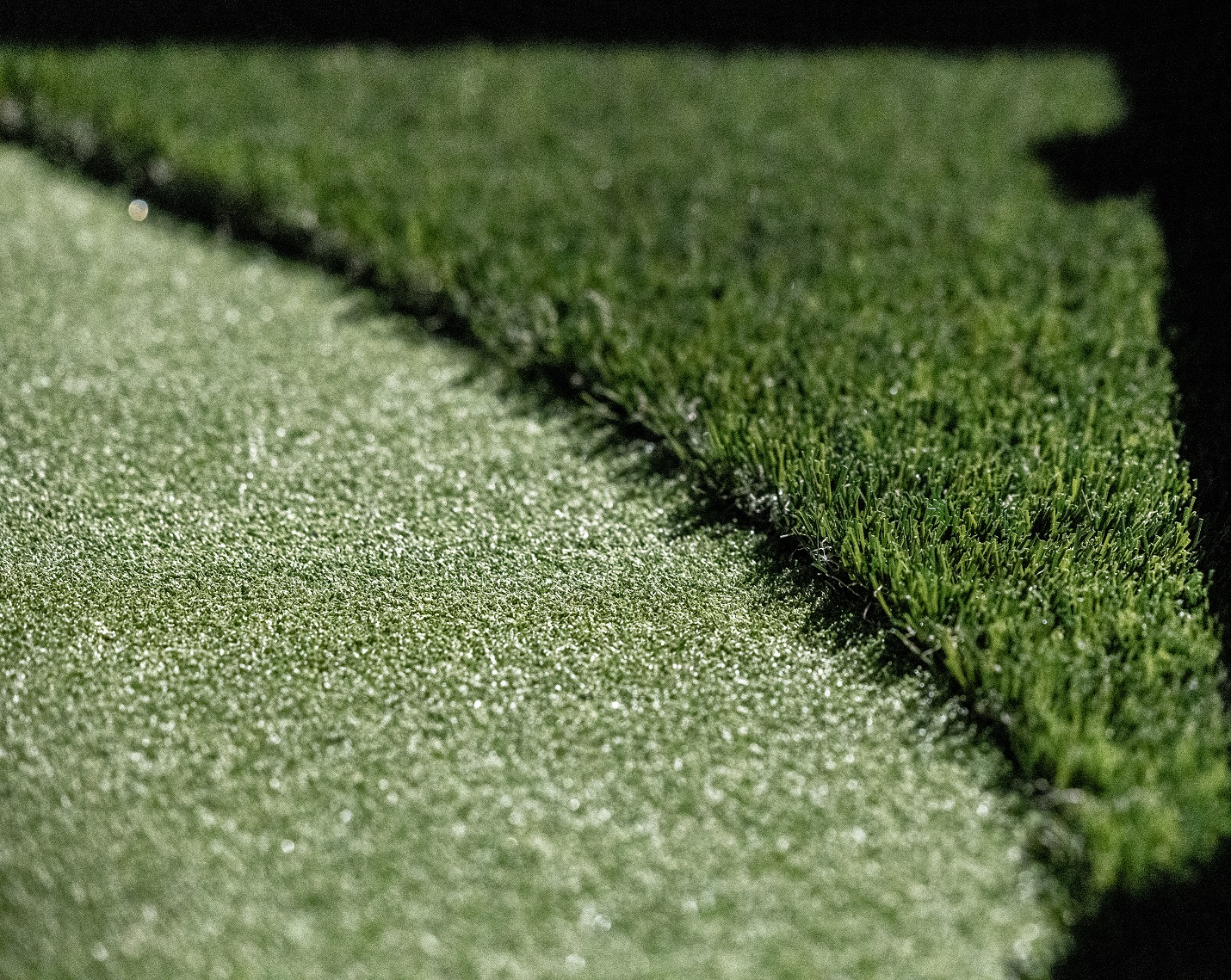
Step 6:
Creating Slopes and Installing Putting Green Cups To add a challenge and realism to your putting green, create slopes and undulations using the crusher dust. This step requires shaping the surface using a rake and compacting it in specific areas. Make sure to create varying degrees of difficulty to keep your putting skills sharp. This is also hard to do, and you may want to hire a professional turf installer if you want varying degrees of slopes. Please contact us at Premium Grass Blades if you would like a professional installation.
Step 7: Installing the Cups
Step A: Pull Back The Turf
Step B: Determine Cup Placement: Before digging, decide on the locations and spacing for your putting green cups. Typically, there are multiple cups strategically placed throughout the green to vary the difficulty levels. Measure and mark the positions where you want the cups to be installed.
Step C: Digging the Holes: Using a shovel, carefully dig holes at each marked position for the cups. The depth of the hole should be just below the height of the turf to ensure the cups sit flush with the surface. Make sure the holes are wide enough to accommodate the cup size and allow for a snug fit.
Step D: Adjusting the Hole Depth: To achieve the correct cup height, you may need to adjust the hole depth. Place a level across the hole and compare it to the surrounding turf. If the hole is too shallow, continue digging until the desired cup height is achieved. If the hole is too deep, add a layer of sand or fine gravel to raise the cup.
Step E: Inserting the Cups: Once the holes are prepared, take the putting green cups and insert them into the holes. Gently press them down to ensure a secure fit. The top lip of the cup should be just below the height of the turf, creating a smooth surface for the ball to roll over.
Step F: Leveling the Cups: To ensure the cups are level, place a level across the top of each cup. Adjust the cup’s position if necessary, making sure it is perfectly horizontal. This step is crucial for a fair and accurate golfing experience.
Step G: Securing the Cups: To prevent the cups from shifting or coming loose, you can add a small amount of adhesive around the base of each cup. Be cautious not to use excessive adhesive, as it may interfere with the ball roll. Also, use a 2×4 wood and rubber mallet and pound the crusher dust around the cup to compact the cup. Then put the piece of cloth or towel between the cup and the 2×4 on top of the cup, and hammer gently down to compact the cup into the ground. Do not hammer too hard to chip the cup. Again, make sure the cup sits just above the ground and almost near flush with the turf.
Step H: Finishing Touches: Inspect the surrounding around each cup to ensure it is smooth and flush with the cup’s lip. Clear and smooth any raised areas of crusher dust around the cups.
Step I: Pull the turf back over the cups and see where the cups are located due to the cups slightly being above the surface. Make sure to align the putting green turf to where you want it. When you find the center of the cup, drill a hole in the center and then star shape to the cup’s inside edges. Make sure not to scrap the cups. Then cut the inside of the turf in the cup in a circular motion. Adjust the turf so it fits snugly around the outside of the cup.
Step 8:
Install the fringe. Make sure to follow the seaming techniques in the artificial turf installation as well as how to nail down and install proper infill.
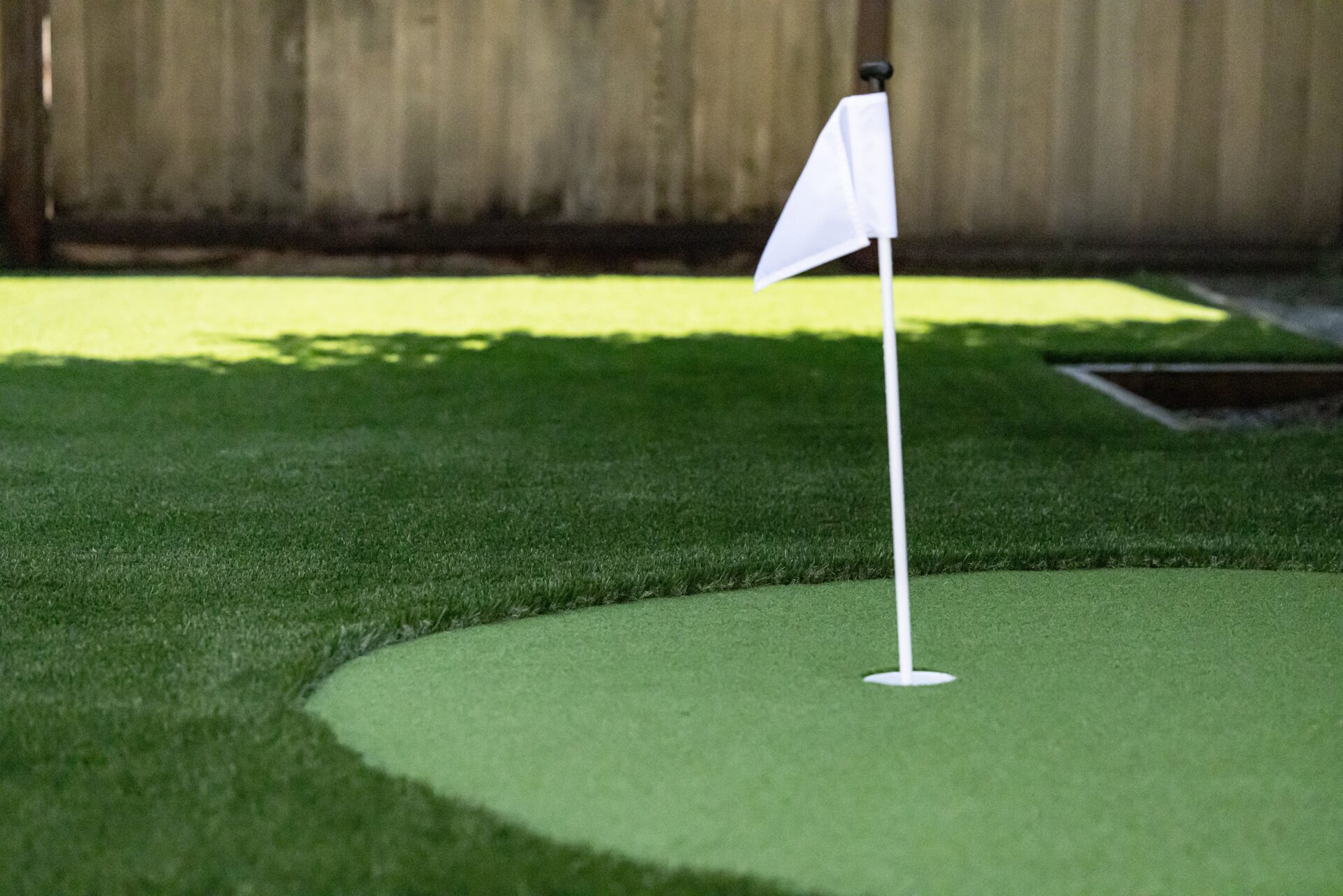
Step 9:
Installing the Putting Green Infill. This is one of the most important aspects of installing the putting green turf, without proper infill, the ball will not roll consistently, and the putting green could shrink and expand excessively in the summer. The durability and longevity of the putting green is directly related to the infill within the turf.
Ensure that your artificial putting green is clean and free from debris or excess dust. Brush or power broom the surface to remove any loose particles and create an even base. Using a drop spreader or broadcast spreader, evenly distribute the silica infill across the surface of the putting green. Start at one end and work your way to the other, ensuring consistent coverage throughout. Be mindful of any sloped or undulated areas and make sure the infill reaches all corners and edges. You should spread 2lb to 2.5 lbs of silica sand per square foot of fine silica sand, which can be purchased at Premium Grass Blades. The putting green should look like a beach. After spreading the sand over the putting green, take a stiff bristle brush and wiggle the sand down into the base of the turf fibers. Do this in a wiggling forward and backward motion. You can then use a power broom to ensure the sand is evenly distributed. Do not nail down the putting green as it will create divets in the turf.
Repeat the Process: To achieve the desired depth and density of infill, repeat the above steps spreading and brushing in the silica infill in multiple passes. This process ensures optimal coverage and proper compaction of the infill material.
Inspecting and Adjusting: After the initial application and brushing, inspect the putting green surface to ensure the infill is evenly distributed and at the desired depth. If necessary, add more infill to any areas that may appear sparse or require additional support.
Testing and Adjusting: Ball Roll Once the infill is evenly distributed and brushed in, roll some golf balls across the putting green to test the ball roll and surface performance. Observe the ball behavior and adjust the amount of infill if needed. The goal is to achieve a smooth, consistent, and true ball roll.
Step 10:
Finishing Touches and Maintenance Once the installation is complete, walk over the entire putting green, checking for any uneven areas or loose turf. Smooth out any imperfections and ensure the turf is secure. To maintain your putting green’s pristine appearance, regularly brush the turf with a stiff-bristled broom or a power brush. Remove any debris or leaves that may accumulate. Install the poles and flags.
Premium Grass Blades: You’re Putting Green Solution For a superior putting experience, trust the high-quality products from Premium Grass Blades. Our Sports Putt 50 artificial turf is specifically designed for putting greens, providing a true ball roll and excellent durability.